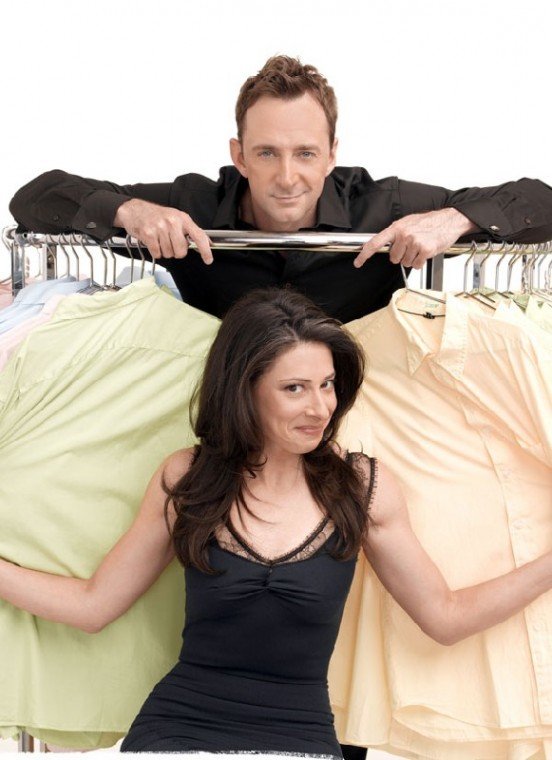Reality TV fashion shows are making the once hoity-toity world
of fashion more accessible to everyday people
By Bridget Byrne, The Associated Press
Reality television is turning the fashion world inside out, reshaping it for mass market appeal.
These days, fashion programming covers everything from ordinary folks buying pants that fit, to models, makeup artists and designers revealing backstage secrets, and experts advising how to dress like a star on a secretary’s budget.
“It’s voracious, the appetite of the public. What was once just a small industry that got a little bit of press has grown up. I do think in part that has to do with reality television,” says Stacy London, co-host of TLC’s popular makeover series, “What Not to Wear.”
“I feel like TV itself is responsible for the sophistication of the mass merchandise out there,” says designer Isaac Mizrahi, host of Style’s “Isaac” talk show and E!’s “Live From the Red Carpet.”
Meanwhile, scripted TV is affecting fashion less than it once did back in the days of “Dynasty” or “Miami Vice” because the shows are produced weeks, even months before they air and today’s ever-changing styles can easily overtake that lag, with excess exposure almost making them ‘out’ before they are truly ‘in.’
Besides, most people probably don’t want to dress like a “CSI” lab worker or a Boston lawyer. “Sex and the City,” where trendy New Yorkers mixed-and-matched designer chic with off-the-rack funk, was probably the last scripted show to have fashion clout.
That’s not to say that scripted stars – like those “Desperate Housewives” – can’t have their share of personal influence. With the help of armies of stylists and loaned designer gowns, they frequently pass for fashion icons, twirling at red-carpet events as they expose themselves to legions of fashion experts who offer their critiques on shows such as Style’s “Fashion Police.”
But Style also airs democratized shows like “The Look for Less.” And it has increased its coverage of New York’s Fashion Week, not just to capitalize on the celebrities attending, but as part of the network’s overall concept of providing insight into how runway style eventually translates into what’s available at the local mall.
“I think one of the biggest shifts in fashion programing has been to make the fashion industry more relatable to the everyday person,” says Saalam Coleman Smith, senior vice president of Style, which sometimes partners with established fashion magazines, including Glamor and Allure, to pass on fashion advice.
But how do these shows touting the wares of designers and advising the purchase of this and that avoid being little more than informercials?
“I think what we always try to do is combine the information and the how-to with good storytelling,” says Coleman Smith. She says the trick is to capitalize on the fashion industry’s “plethora of real life individuals who are incredibly funny, interesting, entertaining in their own right,” and let the “information and how-to come through that.”
Coleman Smith cites Mizrahi as an example of a relatable host, noting how the “sketch and answer” segment of “Isaac,” in which he illustrates style tips in response to audience questions, proves he’s a personality with the ability to “cross that bridge and be on both sides of the runway.”
London, who manages to tell people what not to wear without being mean, says, “I’m not really a fashion expert, I’m a fashion translator.”
She agrees it can be difficult to balance entertainment and information because “fashion as entertainment is a relatively new idea. Fashion as an industry is not,” so the industry’s eagerness to take advantage of a new venue for selling product is understandable.
Therefore, she adds, it’s important “to empower the viewer and say, ‘Look you don’t have to choose everything because someone is trying to shove it down your throat. You have freedom of choice!'”
“Project Runway,” Bravo’s competition series, features 12 contestants snipped “out” by harsh judges as they fulfill a series of design challenges. Last year’s winner, the emotionally and stylishly eclectic Jay McCarroll, is the subject of “Project Jay,” a documentary airing on the channel Wednesday at 11pm EST, as the second season of “Project Runway,” heads toward its finale.
McCarroll thinks “Project Runway” is a hit because, “It’s kind of like ‘American Idol.’ Those people sing and that’s very special, but they don’t have to buy zippers and thread, deal with time management, make a pretty dress in six hours without stressing out … I think it opened up people’s eyes to how hard it is to design.”
Even Sundance Channel is getting into fashion. “House of Boateng,” a follow-along documentary about British men’s-wear designer Ozwald Boateng’s attempt to set up business in America, airs this summer.
Laura Michalchyshyn, programming vice president for the cable channel best known for showcasing obscure films, said the series fits Sundance’s ethic of “freedom of expression.”
Just like fashion itself needs freedom to evolve in order to survive as an industry, so do the shows that cover it.
“What Not to Wear” is always seeking new angles for its format. One new twist, “What Not to Underwear,” airs March 17.
But no matter what the format, reality fashion shows are all about “how empowered somebody feels,” says London. “I think that’s part of what the audience is watching and they are saying, ‘If they can do it, I can do it.'”
Enjoy reality TV shows that deal with fashion?
Check these out:
– ‘Project Runway,’ Bravo
– ‘How Do I Look?,’ Style Network
– ‘Head 2 Toe,’ Oxygen
– ‘A Makeover Story,’ TLC
– ‘Queer Eye for the Straight Guy,’ Bravo
– ‘What Not to Wear,’ TLC
– ‘House of Boateng,’ Sundance Channel












